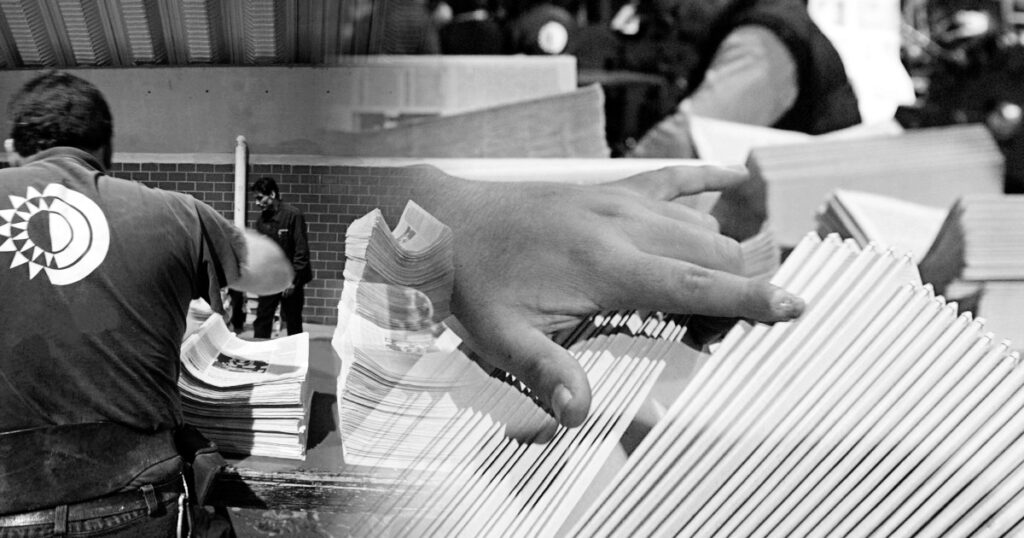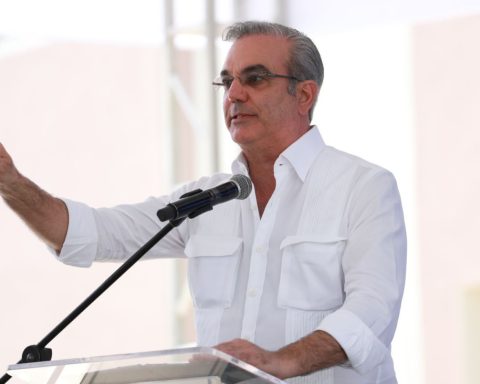Food is becoming more expensive and sometimes more scarce.
It is something that is happening all over the world and that forces people to adapt to new circumstances, even if this means changing what they eat.
It’s 4 pm in the middle of summer in Georgia and the air is sticky when Donna Martin arrives at work.
Another work day means another battle to feed the children of your school district.
Donna is the director of a food service serving 4,200 children as part of a federal free school meals program, but for the past year she has been struggling to get the food she needs.
“We only have two supermarkets for our entire community of 22,000 people,” he says.
“It’s a real food desert.”
Annual food price inflation hit 10.9% in July, the highest since 1979. As prices soar, some of Donna’s food suppliers are no longer interested in feeding schools.
“They’re telling me: ‘They’re very demanding and the margins just aren’t there,'” he explains.
The federal school meal program in the US is strictly regulated. That means products like the breadcrumbs in a chicken nugget should be whole grain and foods should be low in sugar and salt. So Donna has to look for specific types of everything from cereal to bagels to yogurt.
She acknowledges that her suppliers are also struggling. A chronic labor shortage means they can’t find drivers and fuel prices have risen 60% since last year.
When vendors don’t deliver, Donna has to be resourceful. She recently couldn’t afford peanut butter, which kids love, so she replaced it with a bean dip.
“I know the kids aren’t going to like it very much, but I have to give them something to eat,” he says.
Donna and her staff often have to spend mornings and nights raiding the shelves of local grocery stores like Walmart.
“Every day for a week we had to buy all the yogurt in town,” he explains.
“There are a lot of kids really excited to go back to school and I don’t want them to be like, ‘Mom, we didn’t get our shakes today.'”
In what was once a paddy field on the outskirts of Kandy, in central Sri Lanka, Anoma Kumari Paranathala is pulling green beans and fresh mint from the labyrinthine foliage of her garden.
From here it is hard to imagine the chaos in other parts of the country, as the government and economy crumble.
There is a shortage of everything: medicine, fuel and food. Even people with good jobs struggle to buy the basics.
“Now people are worried about their future,” says Paranathala. “They are afraid that there will be nothing to eat.”
The land belongs to his family. They started planting during the pandemic just for fun and now it’s a matter of survival.
Paranthala taught herself how to grow vegetables from books and YouTube videos. She now has tomatoes, spinach, squash, taro root and sweet potatoes in her garden.
Not everyone is lucky enough to have a large tract of land, but many Sri Lankans are turning to another source of food: jackfruit trees.
“In every other garden, there is a jackfruit tree,” says Paranathala.
“But until recently, people didn’t notice jackfruit. They just fell out of the trees and went to waste.”
She began to make a creamy coconut curry with the fruit, thus substituting vegetables that would now be expensive to buy.
Jackfruit is now also appearing in kottu, a popular stir-fried dish sold as street food. And some people are grinding the seeds to make flour for bread, cakes, and roti.
Jackfruit appeared on trendy restaurant menus around the world as a meat substitute a few years ago, but it took a crisis for it to catch on here, where it grows.
So what does fruit taste like? “It’s something that cannot be described,” she says. “It’s heavenly.”
In general, Emmanuel Onuorah has little interest in politics: he is a baker and only wants to sell bread.
But recently in Nigeria, his job has become almost impossible.
“In the last year, wheat flour is up more than 200%, sugar is up nearly 150%, and the eggs we use for baking are up 120%,” he says.
“We are running at a loss,” he says. He has had to lay off 305 of his 350 employees. “How are they going to feed their families?”
As president of the Nigerian Premium Bakers Association, you are at the center of a guild. In July, he caused nearly half a million bakers to close their shops for four days in protest.
He hoped the government would take notice and cut taxes on the products they import.
A combination of poor harvests and higher demand after the pandemic sent wheat and vegetable oil prices soaring around the world. The invasion of Ukraine made things even worse.
In Nigeria, most of the ingredients in a bakery are imported. But a loaf of bread sells for a fraction of what it costs in Europe, making it much harder to absorb price increases.
The country also has an erratic public power supply, so most companies use private generators that burn diesel. But the price of fuel has increased by 30%.
Although rich in oil, Nigeria has few fuel refineries and has to import almost all of its diesel.
Even though his costs have tripled, Onuorah says he can only increase his prices by 10-12%. Your customers can’t pay more than that.
“Nigerians are impoverished, businesses are closing and wages are stagnant, they cannot be overburdened,” he says.
On average, Nigerians spend nearly 60% of their income on food. In the US, by contrast, that figure is closer to 7%.
Going on like this is unsustainable for bakeries. “We are not a charity, we are in business to be profitable.”
“But we keep moving forward,” he says, “so Nigerians can eat.”
Walking up a bumpy road on a hill overlooking the city of Lima, Justina Flores is trying to figure out what she’s going to cook today.
It is a problem that every day is more difficult to solve.
At the height of the pandemic, he got together with 60 of his neighbors to gather the food they had to cook.
Most of the residents of San Juan de Miraflores are domestic workers (cooks, maids, nannies and gardeners), but like Justina, most lost their jobs during the pandemic and their families were hungry.
They began cooking in a pot outside Justina’s house, using firewood they collected for fuel. They then built a small hut and a local priest provided a stove. Justina asked market vendors to donate food that would otherwise have gone to waste.
Two years later they are feeding 75 people, three times a week. Justina, who worked as a kitchen assistant before the covid pandemic, has become a leader in her community. “I keep knocking on doors, looking for support.”
He used to make hearty meat and vegetable stews, served with rice. But in recent months, donations have slowed to a trickle and all types of food are harder to come by.
“We are desperate, I had to reduce the portions,” says Ms. Flores. She has a hard time getting basic things like rice.
What began in April as protests by farmers and transport workers against rising fuel and fertilizer costs has led to a series of strikes that further disrupt food supplies.
Recently, due to rising costs, Justina had to stop serving meat. She tried blood, liver, bones, and sweetbreads because they were affordable. She then hers became too expensive and she replaced them with fried eggs.
When the price of oil skyrocketed, he gave families eggs to cook at home. Now, no eggs either.
So today he is serving pasta with a sauce made from onions and herbs.
However, Justina does not blame farmers for strikes or shortages.
“We can grow food here in Peru, but the government is not helping,” he concludes.
On May 22, an anonymous account tweeting in Arabic urged people to tag images of chicken products with the hashtag #Boycott_Greedy_Chicken_Companies.
A few days later, in Jordan, Salam Nasralla was returning home from the supermarket when he saw the campaign go viral.
“We heard about this everywhere, all our friends and family were talking about it. It was all over social media and TV,” says Nasralla.
She had just noticed the price increase on her own shopping list. As a mother of two children who regularly cooks for her parents, sisters, nieces and nephews, she buys a lot of chicken.
She felt compelled to participate.
For 10 days he avoided chicken, but it was difficult. Because other meat and fish are expensive, Salam and her family eat chicken almost every day.
They ate hummus, falafel, or fried eggplant instead of meat. Twelve days into the campaign, the price of chicken had dropped by a third, almost US$1 (0.7 Dinar) per kilo.
Rami Barhoush, who runs poultry farms and slaughterhouses, supports the idea of boycotts but thinks it was a mistake.
His farms have been struggling with rising costs since the beginning of the year, especially for fuel and chicken feed.
Global factors have combined to push up fuel and grain prices, due to things like China’s surge in pig populations after the swine flu, drought in South America and the war in Ukraine.
In Jordan, the government has proposed a price cap for chicken.
Chicken farmers agreed to a cap until the end of Ramadan. But in early May, they were forced to raise prices, causing a rally. Then the uproar began on social networks.
“The chicken represented discontent with all the rising prices of everything else,” he says.
Nasralla was glad to see that the protest had an effect, but worries that it has not gotten to the heart of the problem.
“Unfortunately, it is the small farmers and chicken vendors who are suffering the most and not the large merchants who put high prices on everything the farmer needs.”
Now you can receive notifications from BBC World. Download the new version of our app and activate it so you don’t miss out on our best content.

















